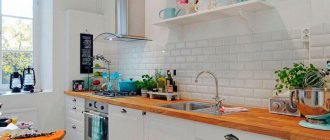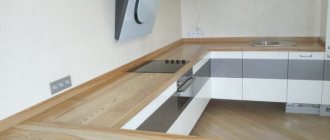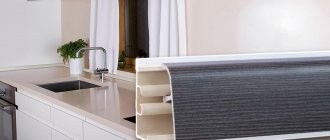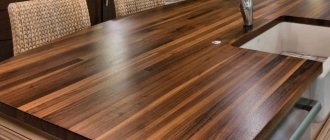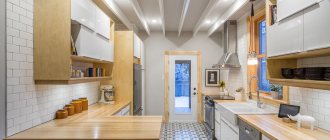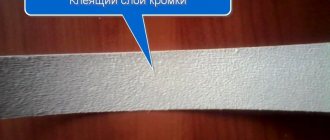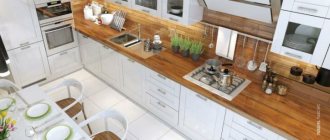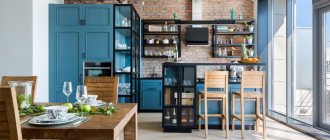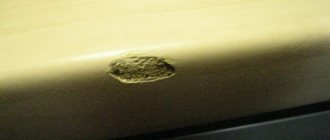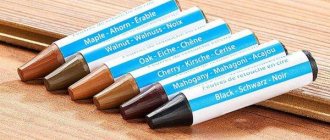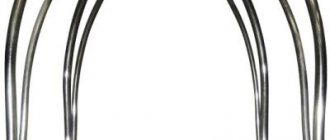Natural wood in the kitchen? Yes, and this article will blow your doubts to smithereens! A wooden countertop is one of the most successful solutions for the kitchen, practical and convenient. You just need to know these 6 professional secrets.
Should there be a wooden countertop in the kitchen? We asked real professionals: qualified designers, craftsmen, technologists and wood specialists - those whose opinions you can trust.
1. Why is a wooden countertop not scary?
On the one hand, smooth, warm wood with a beautiful natural structure is an excellent material for furniture production. Easy to use, environmentally friendly, always fashionable and relevant. Moreover, the tabletop is not a heavy wooden buffet that is impossible to move. It is not necessary to make all the furniture from wood; a completely reasonable modern solution would be to make only the tabletop and, perhaps, some other individual parts from this material.
But many are afraid of how wood may behave, they are afraid of fungus, cracked varnish...
But professionals think differently: “A wooden countertop is not a problem if you apply reasonable, adequate care to it. There are not many materials used for countertops in non-professional kitchens that are not afraid of any impact and do not require maintenance, says Andrey Lyamin-Borodin, builder, general director of the online repair ordering service PriceRemont. “All materials age during use, but the peculiarity of wood is that it can age gracefully.”
So what are we dealing with? Mikhail Vychuzhanin, wood finishing specialist, North House, defines the advantages and disadvantages of wooden countertops as follows.
Pros:
- environmental friendliness of the material;
- beauty and variety of wood texture;
- unlimited product parameters: almost anything can be made from wood in any way;
- easy to update;
- the ability to perform any milling of the edge of the tabletop.
Minuses:
- more careful care is required;
- restoration will be needed after some time;
- relative high cost of the material and work with it.
Design options
The simplest and most modern appearance of any countertop in a work area is clean, straight lines. If this design seems too rough to you, the front ends can be rounded.
Milling is also used on the front and open side ends - it can repeat the pattern on the facade, thereby merging with it.
Advice! Don’t skimp and order a countertop that includes side ends—closed sides give the kitchen a complete look.
In addition to decorative cuts, there are also quite functional ones: for example, near the sink it is logical to make a small bevel and ribs so that water from washed dishes or food flows back into the sink.
The photo shows a kitchen without upper cabinets, the design is a combination of brick, wood, and tiles
Which wood to choose for the countertop?
Here is the answer to the question of what types of wood and wood characteristics are worth paying attention to.
“When deciding on a wooden countertop in the kitchen, please forget about MDF, chipboard and veneer. Only natural wood,” advises Artyom Lepyoshkin, general director of the Dynasty House of Interior Solutions. It's not a matter of harmfulness, but of the properties of the material. The countertop is exposed to aggressive human influence every day: crumbling, cutting, whisking, spilling and spilling are a common occurrence in the kitchen. The surface must be durable, smooth, resistant to cuts, moisture and temperatures.
The classic option is oak or beech: strong and durable wood species. Some choose teak and mebrow. More affordable options: pine, walnut, ash, birch. We prefer larch: you will have to pay more, but it will also last longer. The peculiarity of larch is the very high density of wood; the growth rings are located along the trunk with small intervals. It easily tolerates mechanical damage and deformation, and can withstand high compression and pressure loads. It contains gum, a natural antiseptic that protects against rotting and damage by mold. Ideal for the kitchen. Larch gives off and absorbs moisture when humidity changes.
The manufacturing method also affects durability. A solid wood tabletop is more likely to warp than a laminated wood tabletop assembled from several plates. This method increases flexibility and elasticity.”
“You should pay attention to such points as: the age of the wood, the method of its extraction, storage conditions, the region where the material was brought from,” adds Mikhail Vychuzhanin. He considers oak to be the best type of wood for making countertops. — The stronger and harder the wood, the longer your countertop will serve you. There are countertops made from solid birch, cherry, and walnut.”
Table top made of LSP or MDF - “economy” option
Table tops for a dining table made of laminated chipboard or MDF cannot be called either comfortable or durable. They are used to make economy class kitchen tables, and therefore no one really asks about their characteristics. And there is no need for this: both of these materials are unpretentious, do not require excessive care, and if seriously damaged they can be easily replaced with new ones.
3. How to cover a wooden countertop in the kitchen: Belinka
With the question of how to protect the wood of the tabletop, we turned to the chief technologist of TM Belinka Valery Ermakov.
“The ideal option for protecting a wooden tabletop is a bio-impregnation based on natural vegetable oils and beeswax - that is, oil-wax for wood. Natural oils for wood can make its surface waterproof, which means that the wood is not afraid of fungus and mold. By the way, a countertop impregnated with high-quality oil and wax becomes resistant to standard kitchen detergents—nothing bad will happen to wood from diluted household chemicals. It is even better and more reliable to treat the kitchen work surface with a special oil for wood that comes into contact with food. And of course, no one canceled the more familiar coatings - interior varnish for wood or a combination of colored azure with subsequent application of varnish.”
Purpose of the countertop
First of all, the word “countertop” means the working surface above the floor cabinets. But this is not the only option for using the countertop:
- Make a table out of it by buying several legs, as in the previous version in the photo. This option is often practiced by Ikea.
- Make a bar counter out of it, also purchasing 1-2 legs. Designers often use this trick to create a harmonious atmosphere in the kitchen.
- If you build in a countertop instead of a window sill, you can have lunch and cook food here.
4. How practical is a wooden countertop?
How to protect wood besides using wood products?
“If you want the tabletop to last longer and maintain its appearance, follow simple rules: do not cut anything directly on the wood (perhaps only oak will withstand such violence), do not test the surface for fire resistance and heat resistance,” continues Artyom Lepyoshkin. — Very hot objects can darken wood, ash is especially sensitive. But if you spill wine or juice on the surface, just wipe it with a damp microfiber cloth. Do not use wet rags, this will cause the wood to swell.”
Andrey Lyamin-Borodin advises not to use aggressive household chemicals to wash the countertop: “It happens that drops of such a product fall on the countertop when cleaning the sink or hob. If this product contains, for example, a solvent, it can change the color of the wood and whiten it. An important rule when any stains get on the countertop is to not allow them to be deeply absorbed and, therefore, to remove them immediately. A stain that cannot be washed off can be removed by walking over the area with fine-grained sandpaper, after which the protective coating will need to be renewed.
Regarding the choice of sink - in this case it should be mortise or, in other words, overhead. Washing an under-table installation will create constant exposure to water on the edge of the tabletop, which will inevitably cause it to deteriorate. However, lovers of country style or owners of tabletops made of particularly water-resistant wood may not be bothered by this.”
Advantages and disadvantages
It's worth starting with the benefits that can be highlighted when working in the kitchen.
- wood is a material that is very easy to process . You can give it almost any shape that will perfectly suit your interior;
- wood is a fairly elastic material , which means there will be less mechanical damage in the form of chips;
- If you compare the cost with stone countertops, then wooden ones will be 2–3 times cheaper ;
- at any time you can change the tone of the tabletop itself;
- wood fits perfectly into any interior style and is combined with other types of finishes - glass, tiles, metal, etc.;
- thanks to antistatic properties , you will not experience any problems with dust accumulation;
- In case of minor damage, the product can be easily restored ;
- with wood as with wine. Every year it only gets better. With proper care, it can serve you for more than 25 years.
It is also worth mentioning the negative aspects that may manifest themselves when using wooden countertops in your kitchens:
- if you place hot dishes, marks may form on the countertop;
- it is necessary to periodically change the protective coating, which tends to wear out;
- sharp objects may leave scratches, so the use of special cutting boards is mandatory;
- high cost of natural wood and products made from it;
- wood is very flammable.
And this, perhaps, is where all the arguments ended. That is, even with the naked eye one can see that there are many more positive aspects than negative aspects. Although each owner may have his own reasoning.
5. Will this countertop suit my design?
Wooden surfaces in the kitchen also offer wide design possibilities and are a current trend. Here's what designers think about it.
“The world is becoming more urbanized, and people are experiencing stress due to lack of communication with nature. Natural materials in the interior, such as wood, stone, clay, help modern people feel comfortable in the “concrete jungle,” comments Valentina Konstantinova, creative designer.
The designer gives examples of using wooden tabletops in “star” interiors: “Jake Gyllenhaal, the star of the movie Source Code, uses a wooden tabletop in a Provence-style interior. The kitchen backsplash is finished with small boar tiles, and the furniture is exactly like in the south of France: soft blue with a chamfer and retro handles.
Since wood is not a moisture-resistant material, the part of the countertop adjacent to the sink can be replaced with an artificial stone surface, as in Sarah Jessica Parker's kitchen. The wooden countertop fits perfectly into the modern urban interior of the actress’s kitchen, built on contrasts of textures and colors - white stone and dark brown wood.”
Designer of the interior studio LOFT & HOME Anastasia Yarysheva believes that you can find a place for wood in the kitchen in any style, it is only important to approach the matter correctly. “So, a tabletop made of solid wood with knots, uneven texture, and aging effects will suit a kitchen in a rustic or loft style. But smooth wooden surfaces will look great in modern interiors, high-tech, especially tinted in white, black or graphite - such a tabletop will combine effectively with chrome and glass surfaces. It’s worth paying attention to options made from laminated wood – perhaps even from different species: the rhythmic pattern of the elements can emphasize the beautiful geometry of the room.
Wood selection
Regardless of the species, the wood must be well dried, with a moisture content not exceeding 12%. Boards with wormholes, tar pockets, and rotten knots are rejected. Since the kitchen is characterized by a high level of humidity, wood that is moisture-resistant or treated with a water-repellent composition is chosen. The best materials for this parameter are boards made of larch, oak, birch, pine, and spruce. Supporters of environmental purity will like tabletops made from solid boards. The surface of Iroko and Wenge wood looks original, while possessing high performance qualities. However, it should be borne in mind that the solid wood version will be more expensive and may become deformed over time.
Most of the assortment of wood countertops in stores is of the glued type. They are made of narrow boards - lamellas. When the strips are connected, elasticity and flexibility increase, so the tabletop does not deform. A surface made from lamellas of different types of wood will be effective if they are of contrasting color and differ in texture.
To ensure that heavy utensils can be placed on the countertop, its thickness should be at least 25 mm. Products made from oak, teak, walnut, cherry, sweet cherry, and merbau are recognized as the best in terms of their combination of hardness and resistance to negative influences. In addition to the type of wood, the quality is affected by the type of coating and the composition of the glue.
How to update wood countertops?
Sooner or later, the surface of the wooden tabletop will have to be renewed - the wood will have to be re-saturated with oil. How often should this be done?
“It’s difficult to name a specific period; a lot depends on the specific operating conditions,” answers the Belinka brand technologist. — To understand whether it’s time to renew the countertop, apply a few drops of water to the surface and observe - if the wood quickly absorbs them, it’s time to take out a jar of oil. However, don’t worry, applying oil is not a difficult task, every housewife can handle it on her own.”
We wrote more about how to refresh treated wood surfaces in our blog.
Table top with plastic coating
The task becomes somewhat more complicated if you have to make a small tabletop, or one that also serves as a lid for a kitchen drawer? Solid wood does not look like the best option here, as it quickly loses its initially neat appearance due to temperature changes. It is better to use chipboard covered with protective plastic. A special edge will not let water and dirt into the tabletop.
What will be needed for production?
- Chipboard - 1 sheet.
- Wooden beam (40x40 mm).
- Thin plastic.
- Self-tapping screws (25 mm).
- Drill and wood bits.
- Hacksaw or jigsaw.
- Clamps.
